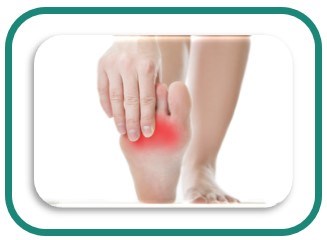Looking after your diabetic foot ulcer to reduce the risk of amputation
What is a diabetic foot ulcer?
You have a diabetic foot ulcer. This means an area of skin has broken down and the tissue under it is now exposed.
In some people with diabetes, the skin does not heal very well and is likely to develop an ulcer or infection after only a minor injury.
About one in ten people with diabetes will develop a foot ulcer at some stage.
The development of foot ulcers in people with diabetes is serious as they are linked to an increased risk of heart attacks, strokes, amputations of the foot or leg and early death.
A foot ulcer can become infected which increases the risk of amputation and, if not treated quickly and effectively, the possibility of early death. If the circulation to your feet is poor, this further increases these risks.
Controlling your diabetes, cholesterol and blood pressure, stopping smoking, increasing cardiovascular exercise and controlling your weight helps to reduce the risk of these life-and limb-threatening problems.
People with foot ulcers will need to ask their Diabetes Team about non-weight-bearing cardiovascular exercise so as not to risk further harm to the damaged foot.
Note: You may be at further risk of cardiovascular problems if you have a family history of heart disease.
As you have a diabetic foot ulcer, you will need regular podiatry treatment. Your podiatrist will draw up a treatment plan for you.
Prescription footwear and insoles can reduce the risk of ulcers but cannot remove the risk altogether.
What should I do if I have a concern or problem with my feet?
Danger signs
During your treatment for this ulcer, if you notice any of these danger signs you must contact a member of your Multi-disciplinary Foot Care Team, local Podiatry Department or GP for advice as soon as possible (within 24 hours).
- Is there any pain or throbbing?
- Does your foot feel hotter than usual?
- Are there any new areas of redness, inflammation or swelling?
- Is there any discharge?
- Is there a new smell from your foot?
- Do you have any flu-like symptoms?
- Have you noticed a rash?
- Are you becoming breathless?
- Is your body temperature above 38.3ºC (101ºF) or below 36ºC (96ºF)?
- Is your heart rate higher than 90 beats per minute?
If you discover any new breaks in the skin or blisters, cover them with a sterile dressing. Do not burst blisters.
If your Multi-disciplinary Foot Care Team, local Podiatry Department or GP are not available, and there is no sign of your foot healing within 24 hours, go to your local accident and emergency department.
Podiatry treatment for your diabetic foot ulcer
Diabetic foot ulcers are sometimes hidden beneath hard skin and can gather dead tissue around them. The podiatrist will need to remove this to help your ulcer to heal. This can cause the ulcer to bleed a little but this is completely normal. Do not try to treat the ulcer yourself.
What can I do to reduce the risk of developing problems?
Do not interfere with your dressing unless you have been properly shown how to remove and replace it and you have suitable dressings to replace the one you are changing.
Continue to check your feet every day
Continue to check your feet every day for any other problem areas or danger signs. If you cannot do this yourself, ask your partner or carer to help you.
Do not get your dressings wet
Getting the dressing wet will prevent healing or allow bacteria to enter the ulcer. This will cause more problems. Your podiatrist may be able to supply you with a dressing protector to keep the dressing dry, or they will give you a form to take to your GP to get a dressing protector on prescription. The dressing protector will allow you to have a bath or shower safely while keeping your dressing dry.
Information regarding a dressing protector available on prescription can be found at https://www.seal-tight.co.uk/presc_original.asp
Moisture the surrounding area of your feet
If your skin is dry, apply a moisturising cream every day, avoiding areas of broken skin and the areas between your toes.
Rest the affected foot
Avoid any unnecessary standing or walking. A wound cannot heal if it is constantly under pressure. Rest as much as possible and, if advised, keep your foot up to help it heal.
Resources:
Looking after your diabetic foot ulcer to reduce the risk of amputation pdf
